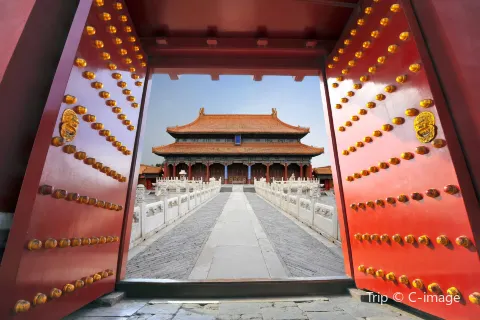https://https://au.trip.com/toplist/tripbest/recommend/anxin/best-things-to-do/10072521900000



Best Things to Do

Top 50 Best Things to Do near Anxin [2025]



Show All Photos

Universal Beijing Resort
4.6
/5
45854 reviews
10
From US$ 64.05

Based on 66 reviews
Universal Beijing Resort and Sorrounding | >100 km from downtown
Phone 4000 688 688
Address: Universal Beijing Resort, Tongzhou District, Beijing
Recommended sightseeing time: 1-2 days
Highlights:
Summer Water Party
The world's fifth Universal Studios theme park
Saved by 8315 users41156 positive reviews
Verified User Reviews



A fantastic experience! The whole point of staying at Universal Studios is to get in early. Staff were constantly checking in to maintain order, making entry very quick! In-room dining was also very responsive, making it a great option when you're tired and don't want to leave. The breakfast buffet was also fantastic, with all sorts of interactive puppets, making it super kid-friendly.
Невероятный опыт. Обязательно стоит посетить парк Universal, если находитесь в Пекине. Новый, множество локаций, хватит занять себя на весь день, интересно будет и детям, и взрослым. Обязательно стоит приезжать к открытию.



Show All Photos

The Palace Museum
4.8
/5
182954 reviews
10
From US$ 8.36

Based on 14,221 reviews
Tian'anmen Square and Wangfujing Area | >100 km from downtown
Phone 4009501925
Address: No. 4, Jingshanqian Street, Dongcheng District, Beijing
Recommended sightseeing time: 0.5-1 day
Highlights:
Admire the flowers and plants in the Imperial Garden in Forbidden City
World Heritage Site
Saved by 9581 users119974 positive reviews
Verified User Reviews



The Forbidden City is a perpetual topic of discussion, as its rich history makes its trivia captivating. First, there's Zhu Di, the Forbidden City's builder. He reigned for 22 years, but lived in the Forbidden City for only three. The Forbidden City was completed in 1420, and Zhu Di relocated the capital from Nanjing to Beijing in 1421. He died in 1424. Secondly, the Forbidden City's bricks were sourced from Linqing, Shandong. The Forbidden City has 8,707 rooms, not 9,999. Fourteen Ming and Qing emperors ruled in the Forbidden City during the Ming Dynasty and ten during the Qing Dynasty. Besides the harem and the cold palace, the most mysterious areas of the Forbidden City include the Yuhua Pavilion. The longest reign in the Forbidden City was held by Emperor Qianlong, who reigned for 60 years and then continued as the Supreme Emperor for another four years after his abdication. The shortest-lived emperor to reside in the Forbidden City was Zhu Changluo of the Ming Dynasty, who stayed for just one month. Furthermore, birds never land on the roofs of the Forbidden City. In 1924, Feng Yuxiang expelled the last emperor Puyi from the palace. In October 1925, the Palace Museum was officially established. This year marks the 100th anniversary of the Forbidden City.
This time when I came to the Forbidden City in Beijing, I made an appointment with Teacher Hou to give a tour guide. His explanation was very vivid and he told the 600-year history of the Forbidden City in an extremely wonderful way. The old and children in my group all loved listening to it. He brought us into the Forbidden City and everyone listened with gusto. I highly recommend Teacher Hou.



Show All Photos

Badaling Great Wall
4.7
/5
52289 reviews
10
From US$ 5.58

Based on 11,093 reviews
Badaling Great Wall/Badaling Wildlife Park | >100 km from downtown
Address: Exit 58 of G6 Beijing-Lhasa Expressway, Yanqing District, Beijing
Recommended sightseeing time: 3-4 hours
Highlights:
Take a cable car to enjoy the fall scenery of The Great Wall
World Heritage Site
Saved by 6721 users37605 positive reviews
Verified User Reviews



I had already visited Badaling in early spring 2010 and had some idea of what to expect. However, during this trip (in July 2025), I couldn’t have imagined just how lush the mountains would be—everything was literally bathed in greenery. Absolutely stunning views of the Great Wall and the mountains unfolded before us. Before visiting Badaling, there’s one key thing you should know: it can get quite crowded, especially on the North Route, as Badaling is the most popular section of the Great Wall due to its proximity to Beijing and convenient transport options. We took the high-speed train from Beijing (during peak seasons, I recommend booking tickets in advance). Since there were no return tickets available for the high-speed train, we decided to take a regular train back (the regular station is also within walking distance), and I must say, it was the best decision. Yes, the train is much slower, but! The route winds through the mountains with absolutely breathtaking views!!! ❤️🏯
We went to Beijing. It is said that one is not a true man if he has not visited the Great Wall, so we went to Badaling Great Wall. The scenery there is beautiful and worth going. Halfway through, we suddenly found a takeaway drone platform on the Great Wall, but we did not try it because of the strong wind. Fortunately, we were prepared to enjoy delicious food on the border. This section of the Great Wall is divided into two sections, north and south. We walked the shorter side, which was very tiring. There are fewer people in this section, so the difficult side may attract more people to challenge it. It is a pity that the Great Wall is not open for long enough. There is no road halfway through. Looking through the wall, the Great Wall outside is all broken rocks and broken arms, which makes people feel sad. Overall, it is still worth a visit.
No.
4


Show All Photos

Yungang Grottoes
4.8
/5
26036 reviews
8.9
From US$ 16.72

Based on 991 reviews
>100 km from downtown
Phone 0352-7992622
Address: No. 1, Yungang Town, Yungang District, Datong City, Shanxi Province
Recommended sightseeing time: 3-4 hours
Highlights:
Stroll through the grottoes and explore Forty Caves
59,000+ stone sculptures inside caves
Saved by 622 users19914 positive reviews
Verified User Reviews



After visiting the Mogao Grottoes in Dunhuang, I came to the Yungang Grottoes. I felt that the experience of the Mogao Grottoes was better. The Mogao Grottoes ticket includes two free movies and a guided tour. The explanations were not too slow and were very good. The Yungang Grottoes were easier to book. I paid for an official guide, but it was probably because there were too many people, so the guide was very rushed and there were a lot of people. It was obviously a weekday and not a holiday, but the Yungang Grottoes were really popular. Although this is the case, the grottoes are amazing and worth seeing.
The Yungang Grottoes are truly a World Cultural Heritage site, majestic and magnificent, steeped in history, and a product of the fusion of different ethnic groups. Although several caves are closed to the public, I'd definitely come back. 😊 I love the art and stories carved into the rock. Cave 6 is a sacred and beautiful Buddhist paradise, and Cave 12 offers a wonderful musical space, filled with songs from the distant Northern Wei Dynasty...
📞Our Ctrip guide, Mr. Li, was excellent. 👍🏻
No.
5


Show All Photos

Prince Kung's Palace Museum
4.7
/5
28778 reviews
8.9
From US$ 5.58

Based on 430 reviews
Houhai Area | >100 km from downtown
Phone 010-83288149
Address: No.14, Liuyin Street, Xicheng District, Beijing
Recommended sightseeing time: 2-4 hours
Highlights:
Ginkgo trees and ancient buildings create an autumn scene
Over 30 different architectural complexes
Saved by 2916 users21639 positive reviews
Verified User Reviews



I came here on a free trip with my children. No one rushed us. We slowly walked around the whole courtyard and visited every attraction. It felt really good. There were not many people. Although the weather was very hot, it was very cool as long as it was indoors. It was also very convenient to enter and go out. It was much better than queuing in the long line at the Forbidden City. It is highly recommended🫰
Under the guidance of our guide Sun, we spent 4 hours to visit Prince Gong's Mansion. Although the weather was very hot, our guide Sun was enthusiastic and humorous. He explained the past and present of Prince Gong's Mansion and showed us the three unique treasures and one treasure of Prince Gong's Mansion. In short, the trip was worthwhile.
No.
6


Show All Photos

Temple of Heaven
4.7
/5
18930 reviews
8.7
From US$ 9.20
Qianmen, The Temple Of Heaven and Chongwenmen | >100 km from downtown
Phone 13716920363
Address: No.1, Tiantan Road, Dongcheng District, Beijing
Recommended sightseeing time: 2-4 hours
Highlights:
Stroll on Ginkgo Avenue's Golden Carpet
World Heritage Site
Saved by 6967 users13379 positive reviews
Verified User Reviews



Tour guide Xiao Cai explained to us, from the tree at the entrance to the patterns on the beams to the main buildings, and we gained a lot of knowledge. The explanation was lively and interesting, not boring at all, and the questions we asked were answered immediately. It was a very fulfilling few hours. If you don't listen to the explanation, you really can't see the doorway by yourself. It rained heavily in the afternoon, and Tour guide Xiao Cai was very patient to wait for everyone. Thank you tour guide ε(*´・ω・)з!
The explanation is professional and vivid, and the history and culture of the Temple of Heaven are explained thoroughly and interestingly! It is highly interactive and fascinating throughout. Both adults and children listen with great interest. It is definitely worth recommending!
No.
7


Show All Photos

Summer Palace
4.7
/5
48276 reviews
8.7
From US$ 13.66

Based on 15,093 reviews
Zhongguancun Area | >100 km from downtown
Address: No. 19, Gongmeng Road, Haidian District, Beijing
Recommended sightseeing time: 0.5-1 day
Highlights:
Overlook autumn scenery from the Tower of Buddhist Incense(Summer Palace)
World Cultural Heritage
Saved by 6744 users28665 positive reviews
Verified User Reviews



The tallest building in the Summer Palace is not the Tower of Buddhist Incense, but the Hall of Wisdom. The Hall of Wisdom is a beamless hall, with its outer layer decorated with yellow and green glazed tiles, and its upper part covered with gray and blue glazed tiles. The whole building is magnificent. The Hall of Wisdom was built during the reign of Emperor Qianlong, and contains 1,110 statues of the Buddha of Infinite Life. In 1900, the Eight-Power Allied Forces entered the Summer Palace and destroyed the Buddha statues on the Hall of Wisdom. Currently, the Buddha statues on the Hall of Wisdom have been basically rebuilt in recent years. There is also a memorial archway in front of the Hall of Buddha, named "The Realm of Incense", which is a glazed roof of seven memorial archways, and it forms an integral part with the Hall of Wisdom. Standing here and looking south, you can see the vast Kunming Lake.
Most tourists enter the Summer Palace from the East Gate, while the North Gate is less crowded and closest to the Beigongmen Station of Metro Line 4. Entering from the North Gate is Suzhou Street, which is a shopping street based on Suzhou Shantang Street. Tickets must be purchased separately. Entering the North Gate is the back mountain of the Summer Palace. The attractions of the back mountain are Xumi Lingjing and the Four Continents, which are a group of mixed Han-Tibetan Buddhist buildings. In 1755, when suppressing the Junggar Rebellion, Qianlong received support from the upper echelons of the four tribes of the Mongolian Walut, and for this reason, he specially built the Four Continents in the back mountain in imitation of the Samye Monastery in Shannan, Tibet. The Four Continents of the Summer Palace and the Four Continents of the Puning Temple in the Eight Outer Temples of the Chengde Mountain Resort use the same drawings and the same construction team. In 1860, the British and French allied forces entered the Summer Palace and burned down the Xumi Spiritual Realm. The current structure was rebuilt in 1980. From 2010 to 2012, it underwent large-scale repairs to restore the four major continents. Above the four major continents is the Sea of Wisdom, which is the tallest building in the Summer Palace and was built during the Qianlong period. The Sea of Wisdom is a stone building. The hall enshrines countless Buddha statues. The outer layer is decorated with glazed tiles and carved with thousands of glazed Buddha statues. When the Eight-Power Allied Forces invaded, the Buddha statues were severely damaged, but now they have been repaired. Climbing up the Sea of Wisdom and looking down at Kunming Lake, one's heart is surging with emotion. History has passed here, and the stories that happened here are unforgettable.
No.
8


Show All Photos

Baotu Spring
4.6
/5
46306 reviews
8.7
From US$ 5.58

Based on 888 reviews
Quancheng Plaza Commercial Area | >100 km from downtown
Phone 0531-86920680
Address: No. 1 Baotu Spring South Road, Lixia District, Jinan City
Recommended sightseeing time: 1-2 hours
Highlights:
Showcasing the life of the Song Dynasty female poet, Li Qingzhao
Saved by 245 users35603 positive reviews
Verified User Reviews



As one of Jinan's three major scenic spots, Baotu Spring has long been a symbol and hallmark of the city, attracting countless visitors. It's said, "A trip to Jinan isn't complete without visiting Baotu Spring." When I think of Baotu Spring, I immediately think of Lao She's descriptions of "the water is as green as the purest plum wine; the water is so clear you can see the fish and gravel beneath the surface." And the three streams of water that "bubble, bubble, bubble, never tired, never retreat." Reading about it as a child filled me with longing. Today, I finally saw it with my own eyes! The springs are bubbling! 🫧
When we entered the scenic area in the evening, there were not so many people inside, and the tour groups had basically left. We could take photos as we pleased, and the experience was very good. It was not far from Daming Lake, and it was about a 20-minute walk away.
No.
9


Show All Photos

MuTianYu Great Wall
4.8
/5
25912 reviews
8.4
From US$ 6.28

Based on 24,427 reviews
Mutianyu Great Wall/Xiangshuihu Great Wall area | >100 km from downtown
Phone 010-61626022
Address: Mutianyu Village, Bohai Town, Huairou District, Beijing
Recommended sightseeing time: 3-5 hours
Highlights:
Overlooking the Great Wall (Cable car)
Shoguan Terrace (Landmark)
Saved by 6771 users17846 positive reviews
Verified User Reviews



This is probably the easiest part of the Great Wall to climb. The renovated stone steps are effortless to climb. It is more convenient to rent a car to go there, which does not waste time, and the return trip is also a resting process.
Very good. I took my parents to the whole city on the ropeway, without having to climb the mountain. The scenery is good and there are relatively few people. It is a recommended scenic spot with complete supporting facilities. I had a lot of fun🥳
No.
10


Show All Photos

Yingxian Wooden Pagoda
4.8
/5
11234 reviews
8.3
From US$ 6.69

Based on 181 reviews
>100 km from downtown
Phone 0349-5088889
Address: Northwest corner of Yingxian city, Shuozhou city
Recommended sightseeing time: 1-2 hours
Highlights:
11-foot Buddha statue inside
Panoramic views of nature & history
Saved by 100 users10211 positive reviews
Verified User Reviews



The Yingxian Wooden Pagoda is truly worthy of its name. Although it was raining and a bit cold, I spent a long time gazing at the pagoda under an umbrella. I spoke to the pagoda, to the passage of time and the people who have come and gone through it. It was as if time and space had converged at this moment.
During a 1933 visit to the Yingxian Wooden Pagoda, Liang Sicheng stumbled upon the Pure Land Temple and marveled at its caisson ceilings. He wrote, "The caisson ceilings of the Heavenly Palace Pavilion are exquisitely designed, incredibly subtle, exquisitely detailed, and unparalleled in their class. They are truly a national treasure."
You can't be more astounded without seeing them in person. A must-see.
1
2
3
4
5




